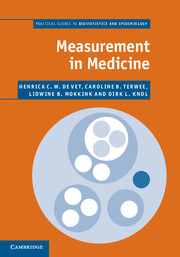Book contents
- Frontmatter
- Contents
- Preface
- 1 Introduction
- 2 Concepts, theories and models, and types of measurements
- 3 Development of a measurement instrument
- 4 Field-testing: item reduction and data structure
- 5 Reliability
- 6 Validity
- 7 Responsiveness
- 8 Interpretability
- 9 Systematic reviews of measurement properties
- References
- Index
2 - Concepts, theories and models, and types of measurements
Published online by Cambridge University Press: 07 September 2011
- Frontmatter
- Contents
- Preface
- 1 Introduction
- 2 Concepts, theories and models, and types of measurements
- 3 Development of a measurement instrument
- 4 Field-testing: item reduction and data structure
- 5 Reliability
- 6 Validity
- 7 Responsiveness
- 8 Interpretability
- 9 Systematic reviews of measurement properties
- References
- Index
Summary
Introduction
This chapter forms the backbone of the book. It deals with choices and decisions about what we measure and how we measure it. In other words, this chapter deals with the conceptual model behind the content of the measurements (what), and the methods of measurements and theories on which these are based (how). As described in Chapter 1, the scope of measurement in medicine is broad and covers many and quite different concepts. It is essential to define explicitly what we want to measure, as that is the ‘beginning of wisdom’.
In this chapter, we will introduce many new terms. An overview of these terms and their explanations is provided in Table 2.1.
Different concepts and constructs require different methods of measurement. This concerns not only the type of measurement instrument, for example an X-ray, performance test or questionnaire, but also the measurement theory underlying the measurements. Many of you may have heard of classical test theory (CTT), and some may also be familiar with item response theory (IRT). Both are measurement theories. We will explain the essentials of different measurement theories and discuss the assumptions to be made.
- Type
- Chapter
- Information
- Measurement in MedicineA Practical Guide, pp. 7 - 29Publisher: Cambridge University PressPrint publication year: 2011
- 7
- Cited by



